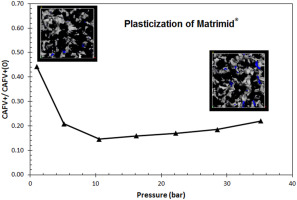当前位置:
X-MOL 学术
›
J. Membr. Sci.
›
论文详情
Our official English website, www.x-mol.net, welcomes your
feedback! (Note: you will need to create a separate account there.)
Prediction of CO 2 -induced plasticization pressure in polyimides via atomistic simulations
Journal of Membrane Science ( IF 8.4 ) Pub Date : 2018-02-01 , DOI: 10.1016/j.memsci.2017.10.038
Marcel Balçık , M. Göktuğ Ahunbay
Journal of Membrane Science ( IF 8.4 ) Pub Date : 2018-02-01 , DOI: 10.1016/j.memsci.2017.10.038
Marcel Balçık , M. Göktuğ Ahunbay

|
Abstract A new methodology is developed to predict CO2 sorption isotherms and CO2 induced plasticization behaviors of glassy polyimides using only fully atomistic simulations, which combines quantum-level charge calculations with integrated molecular dynamics (MD) and Monte-Carlo (MC) simulations. The methodology is validated by reproducing the sorption isotherms of Matrimid and 6FDA-DAM up to 35 bar. Structural changes occurring in a polymer due to CO2 sorption is characterized over a pressure range in terms of change in available CO2-accessible free volume in the polymer structure that is in equilibrium with a given CO2 bulk pressure (CAFV+) with respect to its value before sorption is used to characterize plasticization. It is found that the sorption pressure yielding the minimum value of this change can be correlated to the plasticization pressure of polyimides. Next, this methodology was applied to copolyimides containing pBAPS (bis [4-(4-aminophenoxy) phenyl] sulfone) group for which no high pressure experimental data were reported: 6FDA/BTDA-pBAPS, 6FDA-pBAPS/DABA and 6FDA-pBAPS/mPDA. Radial Distribution Function analyses were performed in order to understand effect of sorption sites on plasticization. Sorption simulations up to 35 bar and CAFV+ analyses suggested that among these three copolyimides, 6FDA-pBAPS/DABA and 6FDA-pBAPS/mPDA are more plasticization resistant compared to Matrimid® and 6FDA-DAM, with potential to be used in CO2/CH4 separation.
中文翻译:

通过原子模拟预测聚酰亚胺中 CO 2 诱导的塑化压力
摘要 开发了一种仅使用完全原子模拟来预测玻璃状聚酰亚胺的 CO2 吸附等温线和 CO2 诱导塑化行为的新方法,该方法将量子级电荷计算与集成分子动力学 (MD) 和蒙特卡罗 (MC) 模拟相结合。该方法通过再现高达 35 bar 的 Matrimid 和 6FDA-DAM 的吸附等温线得到验证。由于 CO2 吸附而在聚合物中发生的结构变化在压力范围内表征为聚合物结构中可用的 CO2 可及自由体积的变化,该结构与给定的 CO2 体积压力 (CAFV+) 相对于其之前的值处于平衡吸附用于表征塑化。发现产生这种变化的最小值的吸附压力可能与聚酰亚胺的增塑压力相关。接下来,将该方法应用于含有 pBAPS(双 [4-(4-氨基苯氧基) 苯基] 砜)基团的共聚酰亚胺,但未报告高压实验数据:6FDA/BTDA-pBAPS、6FDA-pBAPS/DABA 和 6FDA-pBAPS /mPDA。进行径向分布函数分析以了解吸附位点对塑化的影响。高达 35 bar 的吸附模拟和 CAFV+ 分析表明,在这三种共聚酰亚胺中,与 Matrimid® 和 6FDA-DAM 相比,6FDA-pBAPS/DABA 和 6FDA-pBAPS/mPDA 的抗塑化能力更强,有可能用于 CO2/CH4 分离. 该方法适用于含有 pBAPS(双 [4-(4-氨基苯氧基)苯基] 砜)基团的共聚酰亚胺,但未报告高压实验数据:6FDA/BTDA-pBAPS、6FDA-pBAPS/DABA 和 6FDA-pBAPS/mPDA . 进行径向分布函数分析以了解吸附位点对塑化的影响。高达 35 bar 的吸附模拟和 CAFV+ 分析表明,在这三种共聚酰亚胺中,与 Matrimid® 和 6FDA-DAM 相比,6FDA-pBAPS/DABA 和 6FDA-pBAPS/mPDA 的抗塑化能力更强,有可能用于 CO2/CH4 分离. 该方法适用于含有 pBAPS(双 [4-(4-氨基苯氧基)苯基] 砜)基团的共聚酰亚胺,但未报告高压实验数据:6FDA/BTDA-pBAPS、6FDA-pBAPS/DABA 和 6FDA-pBAPS/mPDA . 进行径向分布函数分析以了解吸附位点对塑化的影响。高达 35 bar 的吸附模拟和 CAFV+ 分析表明,在这三种共聚酰亚胺中,与 Matrimid® 和 6FDA-DAM 相比,6FDA-pBAPS/DABA 和 6FDA-pBAPS/mPDA 的抗塑化能力更强,有可能用于 CO2/CH4 分离.
更新日期:2018-02-01
中文翻译:

通过原子模拟预测聚酰亚胺中 CO 2 诱导的塑化压力
摘要 开发了一种仅使用完全原子模拟来预测玻璃状聚酰亚胺的 CO2 吸附等温线和 CO2 诱导塑化行为的新方法,该方法将量子级电荷计算与集成分子动力学 (MD) 和蒙特卡罗 (MC) 模拟相结合。该方法通过再现高达 35 bar 的 Matrimid 和 6FDA-DAM 的吸附等温线得到验证。由于 CO2 吸附而在聚合物中发生的结构变化在压力范围内表征为聚合物结构中可用的 CO2 可及自由体积的变化,该结构与给定的 CO2 体积压力 (CAFV+) 相对于其之前的值处于平衡吸附用于表征塑化。发现产生这种变化的最小值的吸附压力可能与聚酰亚胺的增塑压力相关。接下来,将该方法应用于含有 pBAPS(双 [4-(4-氨基苯氧基) 苯基] 砜)基团的共聚酰亚胺,但未报告高压实验数据:6FDA/BTDA-pBAPS、6FDA-pBAPS/DABA 和 6FDA-pBAPS /mPDA。进行径向分布函数分析以了解吸附位点对塑化的影响。高达 35 bar 的吸附模拟和 CAFV+ 分析表明,在这三种共聚酰亚胺中,与 Matrimid® 和 6FDA-DAM 相比,6FDA-pBAPS/DABA 和 6FDA-pBAPS/mPDA 的抗塑化能力更强,有可能用于 CO2/CH4 分离. 该方法适用于含有 pBAPS(双 [4-(4-氨基苯氧基)苯基] 砜)基团的共聚酰亚胺,但未报告高压实验数据:6FDA/BTDA-pBAPS、6FDA-pBAPS/DABA 和 6FDA-pBAPS/mPDA . 进行径向分布函数分析以了解吸附位点对塑化的影响。高达 35 bar 的吸附模拟和 CAFV+ 分析表明,在这三种共聚酰亚胺中,与 Matrimid® 和 6FDA-DAM 相比,6FDA-pBAPS/DABA 和 6FDA-pBAPS/mPDA 的抗塑化能力更强,有可能用于 CO2/CH4 分离. 该方法适用于含有 pBAPS(双 [4-(4-氨基苯氧基)苯基] 砜)基团的共聚酰亚胺,但未报告高压实验数据:6FDA/BTDA-pBAPS、6FDA-pBAPS/DABA 和 6FDA-pBAPS/mPDA . 进行径向分布函数分析以了解吸附位点对塑化的影响。高达 35 bar 的吸附模拟和 CAFV+ 分析表明,在这三种共聚酰亚胺中,与 Matrimid® 和 6FDA-DAM 相比,6FDA-pBAPS/DABA 和 6FDA-pBAPS/mPDA 的抗塑化能力更强,有可能用于 CO2/CH4 分离.































 京公网安备 11010802027423号
京公网安备 11010802027423号